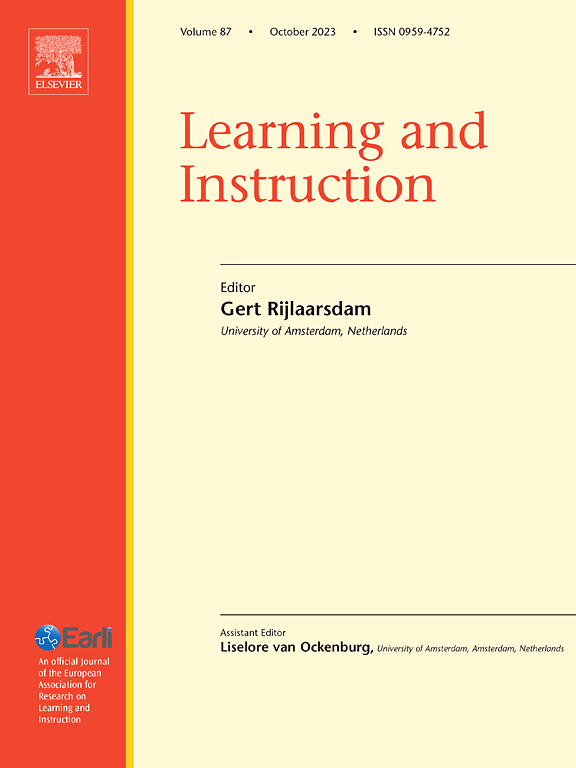Peers’ ideas enhance creativity in collaborative design
IF 4.9
1区 教育学
Q1 EDUCATION & EDUCATIONAL RESEARCH
引用次数: 0
Abstract
Background
Engaging students in collaborative engineering design activities has become increasingly popular in the field of design education. Numerous studies suggest that exposure to peers’ ideas can inspire students and enhance their creativity.
Aims
This study investigates the impact of the timing of idea exposure on students’ design processes and creativity within a collaborative engineering design setting.
Sample
A total of 67 undergraduate students were randomly assigned to one of two conditions: those exposed to a peer's idea before sharing their own ideas (Early Exposure condition), and those exposed to a peer's idea after sharing their own ideas (Late Exposure condition).
Methods
This study employed Eye tracking and screen recording to capture students’ design processes. An independent samples T-test was conducted to examine differences in creativity, time-course analysis was employed to investigate fluctuations in fixation duration over time, and lag sequential analysis was used to identify differences in behavioral patterns between the two conditions.
Results
The study's findings revealed that exposure to a peer idea after sharing one's own significantly enhances student creativity in a collaborative design context. This exposure increased certain behavioral sequences, which are crucial in design activities. Furthermore, students' fixation duration on a peer's ideas mediated the relationship between the timing of idea exposure and the feasibility of their artifacts.
Conclusions
The current study enriches our understanding of how exposure to a peer idea influences student design processes and creativity within a collaborative design context.
同伴的想法可以增强协同设计的创造力
在设计教育领域,让学生参与协同工程设计活动已经变得越来越流行。许多研究表明,接触同龄人的想法可以激发学生的灵感,增强他们的创造力。目的:本研究探讨在协同工程设计环境下,创意暴露时间对学生设计过程和创造力的影响。共有67名本科生被随机分配到两种条件中的一种:一种是在分享自己的想法之前接触到同伴的想法(早期接触条件),另一种是在分享自己的想法之后接触到同伴的想法(后期接触条件)。方法采用眼动法和屏幕记录法捕捉学生的设计过程。采用独立样本t检验来检验创造力的差异,采用时间过程分析来研究注视时间随时间的波动,并采用滞后序列分析来确定两种情况下行为模式的差异。研究结果表明,在分享自己的想法后,接触到同伴的想法显著提高了学生在合作设计环境中的创造力。这种暴露增加了某些行为序列,这在设计活动中是至关重要的。此外,学生对同伴想法的注视持续时间在想法暴露时间与其人工制品的可行性之间起中介作用。当前的研究丰富了我们对在协作设计环境中,同伴想法如何影响学生设计过程和创造力的理解。
本文章由计算机程序翻译,如有差异,请以英文原文为准。
求助全文
约1分钟内获得全文
求助全文
来源期刊

Learning and Instruction
Multiple-
CiteScore
11.30
自引率
4.80%
发文量
109
期刊介绍:
As an international, multi-disciplinary, peer-refereed journal, Learning and Instruction provides a platform for the publication of the most advanced scientific research in the areas of learning, development, instruction and teaching. The journal welcomes original empirical investigations. The papers may represent a variety of theoretical perspectives and different methodological approaches. They may refer to any age level, from infants to adults and to a diversity of learning and instructional settings, from laboratory experiments to field studies. The major criteria in the review and the selection process concern the significance of the contribution to the area of learning and instruction, and the rigor of the study.
 求助内容:
求助内容: 应助结果提醒方式:
应助结果提醒方式:


